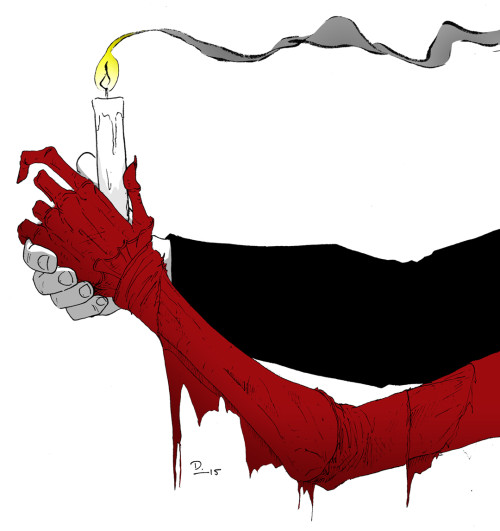Sketch Fridays #04 – Crimson Peak
This week’s Sketch Friday is appropriately (and intentionally) timed for Halloween, but it is also fairly relevant to current cinema, specifically the new Guillermo Del Toro film, Crimson Peak.
As I said on a recent episode of my podcast, I’ve come to think of Del Toro as kind of the Quentin Tarantino of horror/fantasy. It’s about the reference, the creativity, and the scenario rather than really being a deep character study or upending expectations or trends. Despite sounding like something I would normally totally not be into, I am a devotee of (almost) all things Guillermo Del Toro.
I’ve written a bit about him already here on the site, and to reiterate what it is that draws me to him is his dedication to his craft. He knows he’s making a fairy tale movie, a kaiju/mecha movie, a comic book movie. However, that doesn’t stop him from treating each film like it’s the most important, deep movie to ever be made. Del Toro agonizes over the details and really follows through with the Symbolist ethos on letting the details tell more story than, in a sense, the movie itself. While I don’t have the dedication for that kind of attention, it has influenced my approach to Long John without a doubt.
Crimson Peak is Del Toro’s latest movie, and it’s a gothic Victorian ghost story.
To be honest––and this was intentional––the entire story is incredibly self-aware and really undercuts what surprises and horror it does have or, possibly, what could have been. While it has horrific ghosts throughout and a wonderful climax at the end, it is really a stitched-together amalgam of Charlotte Bronte and Edgar Allan Poe. It’s less The Woman in Black and more Jane Eyre, which in itself is a surprising twist for Del Toro who openly admits his love and preference for monsters.
As is the case with any Del Toro movie, what should be inspected most closely is the art direction. This is really what the movie is about. Because the movie is really light on locations, the director was able to sink his teeth into the main set: the house on Crimson Peak itself (mild spoiler, but you would have figured it out anyway). So effective is his direction and design in this movie that it actually lead to my favorite story about watching it.
When I was young, Josh and I would watch as many disgusting horror movies as we could find. However, when I was about 22 years old, I lost the taste for them. Now, I hate being scared, I don’t like the stress or the tension. Plus, Del Toro––as evidenced in movies like Pan’s Labyrinth or The Devil’s Backbone or Cronos––really likes to do visceral and powerful violent things on screen, for the shock value mostly. At the beginning of Crimson Peak, something super horrifying happens and, past that, I was kind of white-knuckling it because I knew he was going to try and get me again with some more unflinching violence at some point. To help distract myself in these situations, I always keep an eye on Nicole because I have determined (through deep-seeded patronizing logic, I’m sure) that she is more squeamish than myself; so I always brace myself to shield her from gross stuff.
When the characters arrive at Allerdale Hall (a crumbling mansion estate on the eponymous peak), it is a sight to behold because of how decrepit it is. In the main entrance, where a large staircase ascends from a beautifully tiled floor, it’s dark and leaves fall as the characters take in the view. The camera tilts up, following the leaves, to reveal a gigantic hole in the roof where a gentle shower of leaves dance in the pale sunlight.
At this moment, my periphery catches movement from Nicole. I glance at her to see her covering her mouth, her eyes widened. I read this as shock, horror, and disgust; so, I leapt into my self-described role of protector. I looked back at the screen and only saw the camera holding on the ceiling. I looked back at her and wondered what happened. Was there a detail in the shadows? A dripping ghoul following the protagonist? Screaming souls painted into the moldy wallpaper?
I leaned in and asked, “Are you okay?”
She opened her hand closest to me and whispered something.
I couldn’t hear her, so I leaned in and asked her to repeat.
“It’s so beautiful,” she said.
I was jealous of her in that moment, to be physically moved by carefully crafted, artful imagery. It was as if Del Toro’s intent reached out and squeezed her lungs, arresting her breath. It showed me how much further I still need to go in my artistic development.
My theater-going experience with Del Toro is really hit and miss, and I enjoy him much more on repeated viewings where I can really control my environment. But even though I didn’t know what to feel upon leaving the theater, Crimson Peak has been a movie that stuck with me all the way through this week, obviously (we saw the film opening weekend). I really enjoyed my time with the movie and will eagerly see it again when it arrives on home video, especially with his commentary added over the top. If you want to see incredible, lovingly crafted visuals, it will be your jam. If you want to have a tense, frightening period movie, you will enjoy yourself. If you want to see a master of his craft, see Crimson Peak.


Discussion (2) ¬